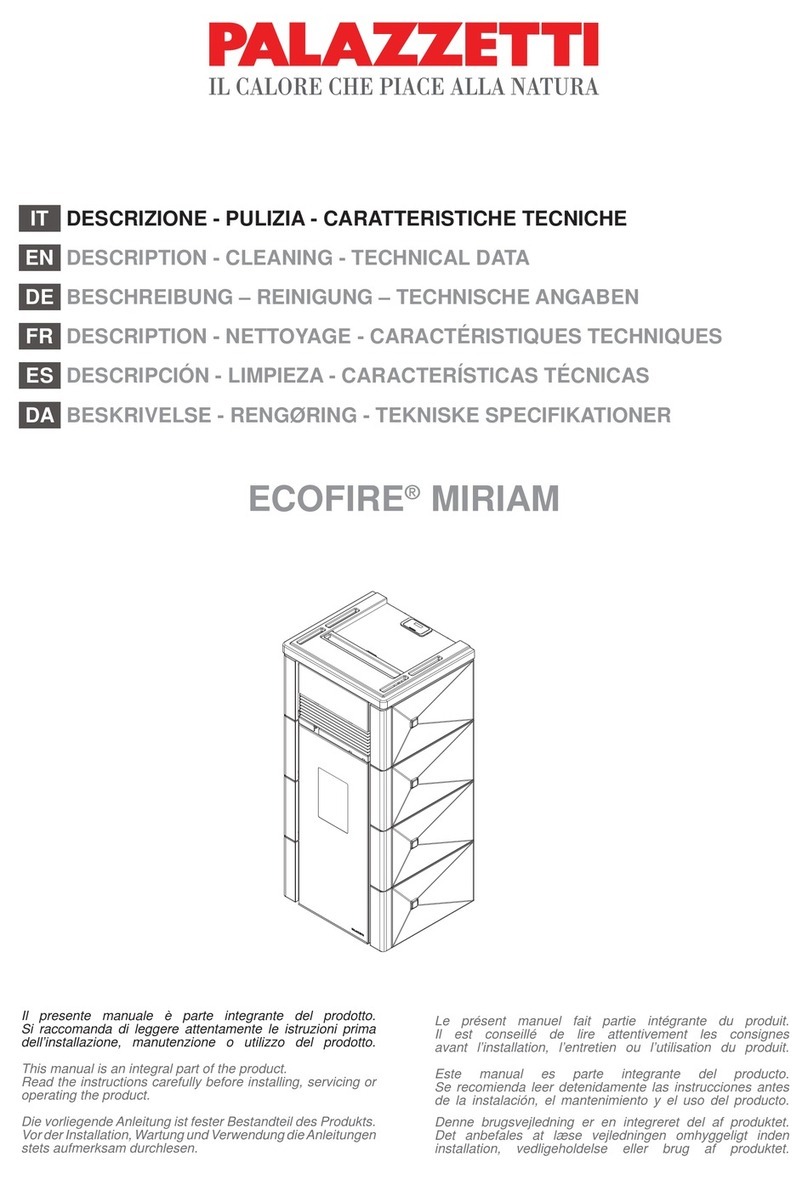
35
EN
Charge pellet
Fuel is loaded from the upper part of the stove by opening
a door. Pour the pellets in the hopper.
This is easier if performed in two steps:
• Pour half of the contents of the bag into the hopper and
wait for the fuel to settle on the bottom.
• Then pour in the second half;
• Keep the cover closed , after loading the pellets , the lid
of the fuel tank;
The stove is a product by heating, presents the external
surfaces particularly hot. For this reason, we recommend
extreme caution when operating in particular:
• Do not touch the stove body and the various components,
do not approach the door , it could cause burns;
• Do not touch the exhaust fumes;
• Do not perform any type of cleaning;
• Do not dump the ashes;
• Do not open the ash tray;
• Be careful that children do not come near;
Never remove the protection grille in the
hopper. When lling, do not let the sack
of pellets touch any hot surfaces.
• The device can be used by children that are not less than
8 years old and people with reduced physical, sensory or
mental capabilities, or lack of experience or knowledge,
provided being under supervision of someone responsible
or after having received instructions relating to the safe
use of the device and to the understanding of the dangers
inherent to it. Children should not play with the device.
Cleaning and maintenance to be performed by the user
should not be made by children without supervision;
• Do not use the stove as a ladder or scaffold;
• Do not put clothes to dry on the stove.
Any clothes hangers and suchlike must be kept a suitable
distance from the stove. - Risk of re
• Carefully explain that the stove is made from material
subjected to high temperatures for the elderly , the
disabled, and in particular for all children, keeping them
away from the stove during operation
• Do not touch the stove with wet hands: the stove has
electrical components that could produce sparks if
handled incorrectly.
• Never open the glass door of the pellet stove while the
stove is in operation.• The stove must be connected to an
electrical system equipped with an earthing conductor in
accordance with regulations 73/23 and 93/98 EEC;
• The system must be of adequate electrical power
declared the stove;
• Do not wash the inside of the stove with water.
The water could damage the electrical insulation, causing
electric shock;
• Do not expose your body to hot air for a long time. Do
not overheat the room you are in and where the stove is
installed.
This can damage the physical conditions and cause
health problems;
• Do not expose to direct the ow of hot air plants or
animals;
• The pellet stove is not a cooking element;
• External surfaces during operation can become very
hot. Do not touch them except with the appropriate
protection.
• The plug of the device power cable must be connected
only after installation and assembly of the device and
must remain accessible after installation, if the unit is not
provided of a double-pole switch suitable and accessible.
• Do not lay objects, glasses, infusers, room perfumers
on the stove, they could be damaged or to damage the
stove (in this case de warranty does not respond).
Instructions for safe and efficient use
The pellets are cylinders of compressed wood, produced from sawdust and wood processing (chips and
sawdust), generally produced by sawmills and carpenters. The binding capacity of the lignin contained
in wood, allows to obtain a compact product without adding additives and foreign chemicals to the
wood, is therefore obtained a natural fuel with high yield.
The use of expired pellets or any other unsuitable material can damage parts of the
thermostove and impair proper operation: this can lead to the termination of the
guarantee, and its producer responsibility.
For our products use pellets diameter 6 mm, length 30 mm and a
maximum of 6% and A1 certied according to the UNI EN ISO 17225-2
standard. Keep the pellets away from heat sources and not in humid
environments or with explosive atmosphere.
Pellet
The pellets are cylinders of compressed wood, produced from sawdust and wood processing (chips



























